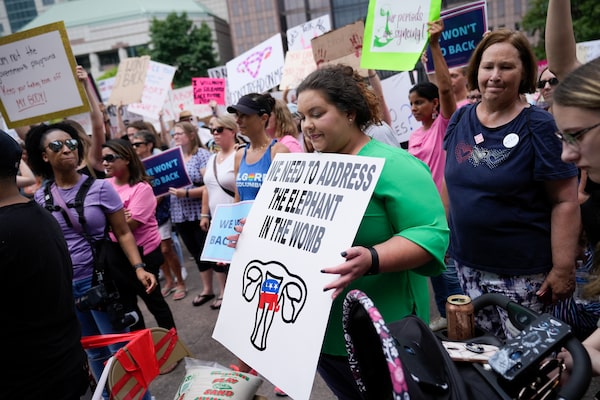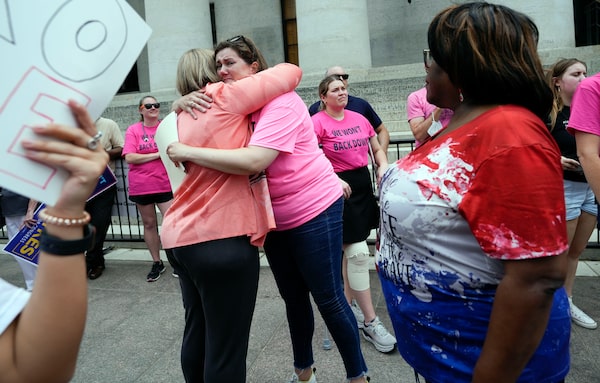
Ohio Senator Amber Stanley of Baltimore, Ohio, holds a sign during a rally organized by the Democratic Party at the Ohio Statehouse following the overturning of Roe v. Wade in Columbus on June 26.Brooke LaValley/The Associated Press
The handwritten messages held aloft at the Ohio Statehouse, like those wielded by crowds that gathered across the U.S. to protest the country’s Supreme Court decision to overturn constitutional rights to abortion, were laced with fury.
“They are coming after your rights next,” warned one. “Keep your rosaries off my ovaries,” implored another. “Stand up fight back,” said another.
The mood was “outrage,” said Cindy Demsey, who chairs the Ohio Democratic Women’s Caucus. “It’s as tense anything I’ve seen, and it’s going to be continual.”
Republicans are pushing back to a “draconian Middle Ages-type situation, that has women subservient again to men,” said David Brock, who chairs the state’s Cuyahoga County Democratic Party. “That’s what their hope is – and what we have to prevent.”
The rallying cry for change has come from the White House itself, with President Joe Biden saying on Friday that “personal freedoms are on the ballot” for midterm elections this fall.
Canadians protest Roe v. Wade reversal, fear LGBTQ rights could be under threat
Roe v. Wade’s fall sets a ‘frightening precedent,’ retired Canadian Supreme Court justice says
How the U.S. Supreme Court is remaking America’s legal landscape
But in Ohio, like many of the states that moved quickly against abortion following the overturn of Roe v. Wade, anger over the abortion decision has only served to underscore a Republican command of political power that will not be easily challenged.
Ohio was once America’s political bellwether, the state whose shifting political preferences tracked and foretold the rise and fall of the left and the right. No longer. Ohio twice voted in large numbers for Donald Trump and has become a firmly held conservative domain.
“Republicans own everything in Ohio,” said Mark Weaver, a political consultant in the state. That includes the Governor’s office, majority positions in the state House of Representatives and the state Senate – and a majority among delegates to federal Congress.
The Supreme Court decision, released Friday, struck down a constitutional right to abortion, leaving the authority to regulate such procedures to individual states. Researchers say 26 states are certain or likely to restrict abortion. Nine have already enacted bans, with seven more likely to follow soon.

Liz Walters, the Chair of the Ohio Democratic Party, tearfully hugs Gubernatorial candidate Nan Whaley in Columbus.Brooke LaValley/The Associated Press
But the states angriest about the Supreme Court Decision “are the blue states” – those with Democrats in power, and abortion rights protected – “and their laws are not changing,” Mr. Weaver said.
In Ohio, meanwhile, the state moved within hours of the Supreme Court decision to activate a 2019 law that bans abortions once a fetal heartbeat is detected, which typically happens at about six weeks of gestational age.
Tighter restrictions are coming.
Earlier this year, Ohio’s state Congress began to consider a bill that would ban nearly all abortions, without exemptions for rape or incest. In an April debate, the bill’s House of Representatives sponsor, Republican Jean Schmidt, called rape “an opportunity for that woman, no matter how young or old she is” to deliver a child.
Supporters now expect that bill, the Human Life Protection Act, to move ahead quickly.
“We believe within the next 60 to 90 days, we’ll get it to the Governor’s desk for signature,” said Mike Gonidakis, president of Ohio Right to Life.
“We will end abortion in 2022 in Ohio. It’s going to happen. And we have the votes.”
Hundreds of people attended a weekend church rally to “thank the Lord and to celebrate,” Mr. Gonidakis said. It was an occasion to mark an end to “over 50 years living in a country and a state that allowed for abortion.” Among the next priorities, he said, is to find some way to act against the purchase of abortion drugs from China, Mexico or Canada.
“We need to sit down in a room, all of us, and figure out: How do we protect ourselves against that?”
Abortion rights protesters gather for a rally in Columbus on June 24.MEGAN JELINGER/Reuters
Opinion polls have found Ohioans divided on abortion, with roughly half saying it should be legal all or most of the time, and a slightly smaller percentage saying it should largely be illegal. Nationally, more than two-thirds of Americans say decisions on abortion should be made by women with their doctors, rather than by government.
“The Supreme Court is out of sync with what the American people want,” said Ms. Demsey, the chair of the Ohio Democratic Women’s Caucus. “This decision is going to galvanize us.”
But such nuance is unlikely to emerge in the current political climate.
In Ohio, Republicans have defied court orders against the creation of gerrymandered voting district maps that have, scholars say, given the party a significant electoral advantage.
“Republicans have drawn themselves a great set of maps in Ohio,” and can “effectively do anything they want,” said David Niven, a political scholar at the University of Cincinnati. At the moment, “our state legislature is so dominated by the right that it is more conservative on the whole than South Carolina’s.”
Earlier this month, the state’s House of Representatives passed a bill that would require athletes to undergo a genital inspection if their gender is questioned. “The abortion ban, by contrast, is relatively moderate politics,” said Prof. Niven.
Anti-abortion campaigners gather outside of an abortion clinic in Dayton, Ohio, on June 24.MEGAN JELINGER/Reuters
For Democrats in the U.S., a central question now is whether abortion can begin to erode conservative political support.
Republicans and some political analysts scoff at the idea, saying economic issues such as inflation and gasoline prices will remain top of mind for voters. Besides, Mr. Weaver said, success begets success. “For the longest time, conservative activists laboured in the shadows,” he said. Now, “conservative grassroots people are seeing victories – and that emboldens them to get even more involved.”
But abortion is unlike other issues, Prof. Niven noted. After years of Democrats struggling to campaign on issues that connected directly to voters, abortion is “something you can point to and show people: This is happening in your life, to your family,” he said. He expects the Supreme Court decision to mark the beginning of a broader political shift back toward the left.
“The price of winning now is losing later and Republicans are going to pay the price for winning on this issue in this moment,” he said.
Our Morning Update and Evening Update newsletters are written by Globe editors, giving you a concise summary of the day’s most important headlines. Sign up today.
 Nathan VanderKlippe
Nathan VanderKlippe